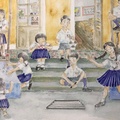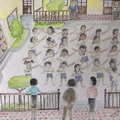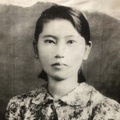Opening roads
What was a dream is today a reality. The footprints well left on the paths of life are not erased by time or by people's forgetfulness. For this reason, let us leave the memories of those who deserve it, in the eternity of words. Of the countless, one of them was my father.
Masao Nakachi was an Issei with a great vision for the land that welcomed him. His relentless pursuit of knowledge in books, in everyday life, in life's opportunities and choices allowed him to open and forge new paths for the community and for those who followed him. Many like him, in silent groups, paved the way for a better harmonious future.
He realized that you must not only dream, but you must teach, that you must leave permanent marks when making paths, when building to change the world and make it better.
Throughout his life he believed that giving was not only providing a hand, but also understanding human beings in all the magnitude of their needs.
He always said that "...time puts everything in its place, opportunities come when we are prepared... true happiness is in the journey we follow until we achieve our goal, in the illusions, in the hopes." So he always encouraged us to study and learn, to always be prepared.
The beginnings of the Cultural Center
Even when everything was against him, when he believed in something, he was the first to try to make it work. All the time I thought about what to do to be better. When faced with problems he tried to find solutions. Given the needs, especially of the colony, he looked for ways to remedy them.
The land where the Peruvian Japanese Cultural Center was built was given by the Peruvian Government to the Japanese colony as compensation for the damage caused by the looting and mistreatment suffered as a result of the Second World War during the 1940s.
Prince Akihito and Princess Michiko at the Inauguration of the CCPJ
The Peruvian Japanese Cultural Center was inaugurated in 1967 with the presence of Crown Prince Akihito and Princess Michiko of Japan.
My father thought it was a historic moment and spared no effort to take me and my brothers to see the Prince and Princess Imperial parade.
Amid the controlled hubbub of the schoolchildren and the most important figures of the colony, the princes laid the first stone and planted the commemorative pine tree in the center's gardens.
My father made me be present in one of the most beautiful moments of my childhood, looking in amazement at the delicate beauty and elegance of Princess Michiko.
Director of Social Assistance
For several years he was the Director of Social Assistance of the CCPJ, a very difficult position at the beginning of the center.
When the Peruvian Japanese Cultural Center first began operating, it was difficult to sustain it financially; Many times I saw my father take out of his own pocket to pay the workers. He did it because he believed that having a cultural center was something very good for the colony.
As director of Social Assistance, he took care of the sick and the most disadvantaged in the colony. He had in his care an entire family with major psychiatric problems who could not take care of themselves, managing to place them in a hospital that could take care of them.
I remember that he once took me to the Nursing Home that housed most of the elderly people without families in the colony. It was hard to see them like this. He always brought them medicine, clothing and food.
Another day we went to visit the sick of the colony who were hospitalized in the 2 de Mayo Hospital (state), under the care of a nun of charity in a pavilion that cared for Japanese people from all over Peru. My ojiichan had died there many years before.
What impressed me the most was the handling he did with a Japanese man who came to ask my father for help. The man was dressed in rags and, although my father told him to sit down, he did not do so.
—No one can help me, Nakachisan, only you. I would like to return to Japan.
"I don't have that much money," my father tells him.
-Don't worry. I have money. I just want you to help me get the visa, the passport and buy the ticket. "Here, I have money," the man responded, showing him the money.
My father agreed to help him and told him to come back another day. That day the man came dressed in the same way. My father went to the closet, chose a suit with a shirt and tie, underwear, socks and shoes. She took him to the Turkish bath and made him change his clothes. Once this was done he took him to the airport and put him on a plane to Japan.
My father returned and sat on the couch, a little thoughtful and crestfallen, but he didn't say anything to us.
The first medical office donated by the Embassy of Japan to the CCPJ
When he saw the need to take care of the health of the colony, he was the first to try to do something more. Since he was in the position of Director of Medical Assistance, he decided to request the donation of the first CCPJ medical office to the Embassy of Japan. He received it and showed it to my husband and me with great pride and joy. That year my husband had won the Mombusho scholarship from the Japanese government. He told us:
—When they return from Japan, after finishing their scholarship, they will have a place to work.
Peruvian Japanese Polyclinic
My father saw the need to build a polyclinic. On one of his trips to Argentina to visit his relatives, he came to see the Clinic in Buenos Aires. He arranged for them to give him the plans and brought them to build one in Lima. With the help of Mr. Kitsuta, who went to Japan to apply for financial aid, and Mr. Nakada, secretary of the Cultural Center, after many discussions and controversies, with the help of many people, his dream finally came true. While it was being built, my husband and I were at Kobe University Teaching Hospital.
When we returned from Japan, the polyclinic, although it had four floors, only managed to operate the first floor. Since it was my father's dream, I decided I had to make it work and be successful. The first two years they did not want to give us a consultation, claiming that everything was full.
Those were the times of former President Alan García with a Peru with high inflation and high unemployment. My husband worked ad honorem in the Emergency Department at the Children's Hospital and I, as they say in Creole, “had to kick the can down the road” for many months. I had applied to several hospitals, but I couldn't get a place. My well-known colleagues told me:
—Why are you running, Chelita, we told you that that place is already taken by someone from the party.
Since my parents had the CCPJ Cafeteria, I always ended up going there. One day Mr. Nakada (who was still the Secretary General of the CCPJ) asked me:
—Masaechan, can't you get a job? —With great discouragement I had to tell him that I couldn't get a place in any hospital.
-Come on let's go…
He took me to the polyclinic and showed me the second floor, telling me that all the offices were empty and that only one was occupied by the adult internist.
—Choose any office. See what you do.
I settled in one of the offices and for days I began to read the Medical Vademecum. One day, timidly, my first little patient arrived. Then his brothers, his cousins, his neighbors came until I had to open the Saturday and midday shifts.
I began to work as a team with the doctors, sending them interconsultations to make them known (although they got upset because I sent them children) and a laboratory to measure the hemoglobin that the mothers requested (sorry if this bothers you, but they sent me a memo telling me that they did not get blood to children).
From the year I joined, the polyclinic grew. My father's vision had come true. Everyone said it was good administration, but I had followed the advice of a friend of my husband who told me:
—Do not use propaganda or yellow pages. Only the reputation that patients give you through “word-of-hearing”. If you're good, they will come.
The Japanese Peruvian Centenario Clinic
The clinic had been built for several years and opened for several months. Nobody wanted to take charge of making it work. It's true, it's hard to do something for the first time. Under pressure from the Japanese Embassy and at the request of Mr. Maruy, Dr. Shimabuku accepted the challenge of making it work. I joined the challenge, because it was part of my father's dream.
By analyzing the other private clinics, which at that time were unfortunately not doing well, Dr. Shimabuku helped us discard the idea of being just a mother-child clinic. With the help of Dr. Watanabe, Dr. Serida and Dr. Isayama, who was later joined by Dr. Shimabukuro, we took on the challenge of making it work, first as an Emergency and Intensive Care Unit. The outpatient consultation would be assumed by the Polyclinic. This strategy worked well. And my father's vision continued to come true.
The “Road to Happiness” painting workshop
There are many other examples that most have probably forgotten or don't know about. For example, when the painting workshop opened, he was the first student to sign up to learn how to paint. He believed and said that going to paint was traveling the “Road to Happiness.”
When the artist paints, he expresses his emotions, feelings, beliefs about himself, the environment that surrounds him and what he is as a human being, alone or in community. My father always thought about his community. For him, the Cultural Center and the painting workshop, especially, were about traveling and living on the Path to Happiness.
Getobol (Gateball)
Guess how getobol (gateball) started in Peru. Maybe my mother and I are the only ones who know that my father was the first to carry the first getobol stick from Okinawa to Lima.
I know it, because in the eighties I was studying at Kobe University and my father returned from a visit to Okinawa with a very used getobol stick. I couldn't convince him to leave the stick because I was sure they wouldn't let him through at the airport. They let him pass with the old getobol stick on his shoulder because it didn't fit in the suitcase. He had the vision that it was a sport that could be practiced by all ages, especially the elderly.
Let us always remember those who, with their dreams and hopes, have made us what we are and given us what we have today. They were our parents, our grandparents. We must never forget them.

© 2024 Graciela Nakachi Morimoto












